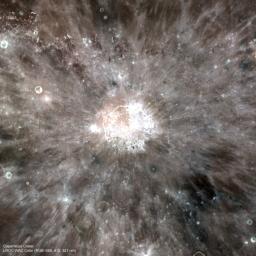
|
Absolute Time
- Click the image above for a larger view
- Full-Res JPEG (1100 x 1100) (203.4 kB)
- Full-Res TIFF (1100 x 1100) (3.6 MB)
Caption:
LROC Wide Angle Camera (WAC) visible to ultraviolet portrait of Copernicus crater, image 458 kilometers (284 miles) wide.
Understanding how scientists determine the relative age of geologic units on the Moon is straightforward, most of the time. One simply follows the law of superposition; what is on top is younger, what is below is older. In some cases, superposition relations are not clear, so scientists then compare crater densities. That is the number of impact craters on a common size of ground. Since impacts occur randomly both in time and on the Moon's surface, any piece of ground has an equal chance of being hit. Over time, the number craters in a given area increases. Simply stated, the older an area the more craters you will find.
Background Info:
NASA's Goddard Space Flight Center built and manages the mission for the Exploration Systems Mission Directorate at NASA Headquarters in Washington. The Lunar Reconnaissance Orbiter Camera was designed to acquire data for landing site certification and to conduct polar illumination studies and global mapping. Operated by Arizona State University, LROC consists of a pair of narrow-angle cameras (NAC) and a single wide-angle camera (WAC). The mission is expected to return over 70 terabytes of image data.
Cataloging Keywords:
| Name | Value | Additional Values |
|---|---|---|
| Target | Moon | |
| System | Earth | |
| Target Type | Satellite | |
| Mission | Lunar Reconnaissance Orbiter (LRO) | |
| Instrument Host | Lunar Reconnaissance Orbiter | |
| Host Type | Orbiter | |
| Instrument | Lunar Reconnaissance Orbiter Camera (WAC) | |
| Detector | Narrow Angle Camera (NAC), Wide Angle Camera (WAC) | |
| Extra Keywords | Color, Crater, Impact, Ultraviolet | |
| Acquisition Date | ||
| Release Date | 2012-03-19 | |
| Date in Caption | ||
| Image Credit | NASA/GSFC/Arizona State University | |
| Source | photojournal.jpl.nasa.gov/catalog/PIA13964 | |
| Identifier | PIA13964 | |
